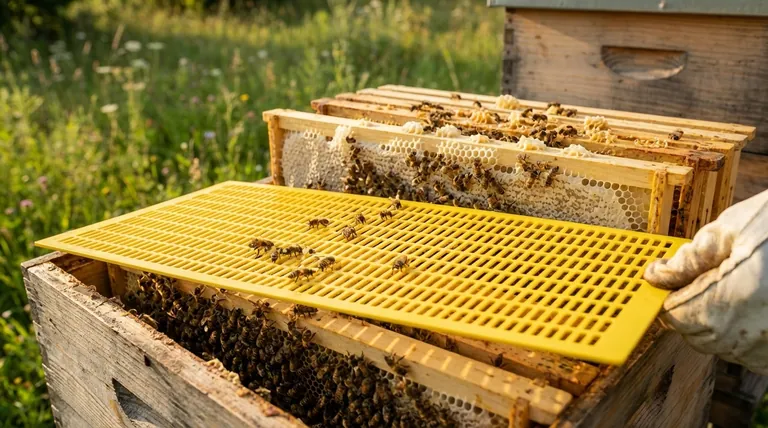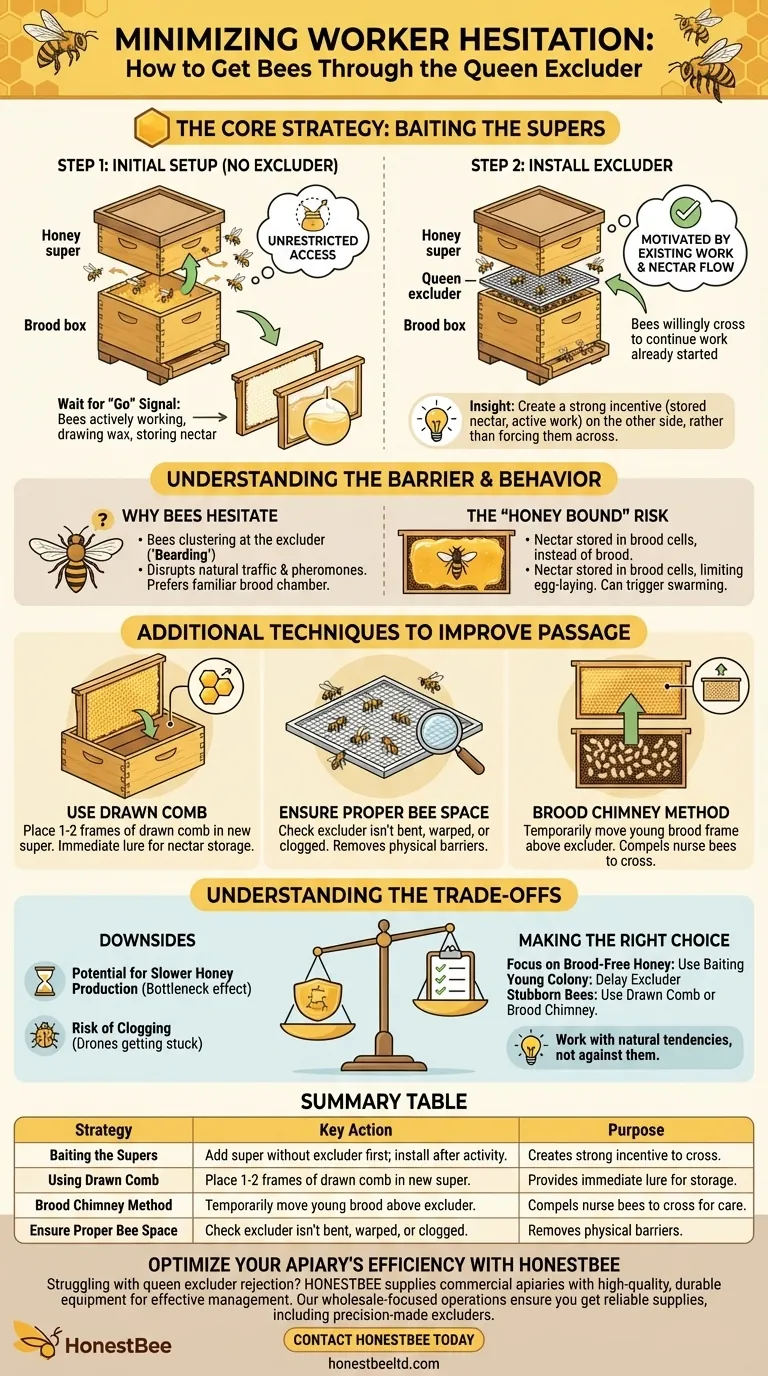The most effective way to get worker bees to pass through a queen excluder is to entice them by allowing them to start working in the honey supers before you install it. Once bees have begun storing nectar and drawing out comb in the supers, their instinct to continue that work will motivate them to cross the barrier.
A queen excluder is often seen by bees as an unnatural and arbitrary obstacle. The solution isn't to force them across, but to create such a strong incentive on the other side—in the form of stored nectar and active work—that they willingly push through to get the job done.

Understanding Bee Behavior and the "Excluder Barrier"
Why Bees Hesitate
A queen excluder is a foreign object in the hive that disrupts the natural flow of traffic and pheromones. Bees can be reluctant to pass through this barrier, preferring to stay in the familiar brood chamber. This hesitation is often called "bearding" on the excluder.
The "Honey Bound" Risk
When workers refuse to move into the supers, they begin storing incoming nectar in the brood chamber. This backfilling process fills cells that the queen needs for laying eggs, which can severely limit colony growth and may even trigger the colony to swarm.
The Core Strategy: Baiting the Supers
This technique works by leveraging the bees' natural instinct to continue work that has already been started.
The Initial Setup (Without the Excluder)
When you are ready to add your first honey super, place it directly on top of the uppermost brood box without the queen excluder. This gives the bees unrestricted access.
Look for the "Go" Signal
Wait until you see the bees actively working in the super. The key sign is seeing fresh white wax being drawn out on the frames and nectar being deposited in the cells. This indicates they have accepted the new space.
Install the Excluder
Once the bees are clearly committed to working in the super, you can install the queen excluder. Place it between the top brood box and the now-active honey super. Because the scent of nectar and the urge to continue their work is already established above, the workers will readily pass through to continue their task.
Additional Techniques to Improve Passage
If you still face resistance after baiting, or for subsequent supers, these methods can significantly help.
Use Drawn Comb
Nothing encourages bees into a super like fully drawn-out comb. If you have frames of drawn comb from a previous harvest, placing one or two in the center of the new super provides an immediate place for nectar storage, acting as a powerful lure.
Ensure Proper Bee Space
Check that your queen excluder is not bent, warped, or clogged with propolis. Improper "bee space" can make passage physically difficult for workers, especially when they are engorged with nectar. A well-maintained excluder is crucial.
The "Brood Chimney" Method
For a very reluctant colony, you can temporarily move a single frame containing young, uncapped brood from the brood box up into the center of the honey super (above the excluder). Nurse bees are compelled to cross the excluder to care for the larvae, establishing a strong and consistent traffic pattern. After a week, you can move the brood frame back down.
Understanding the Trade-offs
Using a queen excluder is a management decision with clear benefits and potential downsides.
Potential for Slower Honey Production
Even with these techniques, an excluder creates a bottleneck. Honey production can be slightly slower than in a hive without one, as it takes workers more time and effort to move through the barrier.
Risk of Clogging
Drones, which are larger than workers, cannot pass through the excluder. They can sometimes get stuck and die, which can clog the grid and further impede worker movement. Regular inspection helps prevent this.
The Importance of Timing
The primary mistake is adding the excluder too early, before the colony is strong enough and ready to expand into the supers. This creates an unnecessary barrier that can stifle colony development.
Making the Right Choice for Your Hive
- If your primary focus is pure, brood-free honey: Use the baiting method to ensure bees accept the excluder and keep the queen out of your supers.
- If your colony is young or not yet booming: Consider leaving the excluder off entirely until the bees have drawn out and started filling the first honey super.
- If your bees are consistently stubborn: Use a frame of drawn comb or the "brood chimney" method to create an irresistible reason for them to move upward.
Ultimately, successful hive management comes from working with the bees' natural tendencies, not against them.
Summary Table:
| Strategy | Key Action | Purpose |
|---|---|---|
| Baiting the Supers | Add super without excluder first; install excluder after bees are active. | Creates a strong incentive for bees to cross. |
| Using Drawn Comb | Place 1-2 frames of drawn comb in the new super. | Provides an immediate lure for nectar storage. |
| Brood Chimney Method | Temporarily move a frame of young brood above the excluder. | Compels nurse bees to cross to care for larvae. |
| Ensure Proper Bee Space | Check excluder is not bent, warped, or clogged. | Removes physical barriers to easy passage. |
Optimize Your Apiary's Efficiency with HONESTBEE
Struggling with queen excluder rejection or slow honey production? HONESTBEE supplies commercial apiaries and beekeeping equipment distributors with the high-quality, durable supplies needed for effective hive management. Our wholesale-focused operations ensure you get the reliable equipment—including precision-made excluders—that helps you work with your bees' instincts for a more productive operation.
Contact HONESTBEE today to discuss your wholesale needs and discover how our beekeeping solutions can support your success.
Visual Guide

Related Products
- Professional Plastic Queen Excluder for Modern Beekeeping
- Wooden Queen Bee Excluder for Beekeeping
- Premium Wood Framed Metal Wire Queen Bee Excluder
- Metal Queen Bee Excluder for Beekeeping
- High Performance Plastic Queen Excluder for Beekeeping and Apiary Management
People Also Ask
- What is the role of a queen excluder when adding a super? Ensure Brood-Free Honey Harvests
- How do queen excluders work in terms of spacing and bee movement? A Guide to Precision Hive Management
- What is the purpose of a queen excluder when adding a super? Streamline Your Honey Harvest
- What is a Queen Excluder and how does it work? Achieve Purer Honey & Better Hive Control
- What is the primary function of a queen excluder in beekeeping? Control Hive Layout for Efficient Honey Harvesting



















